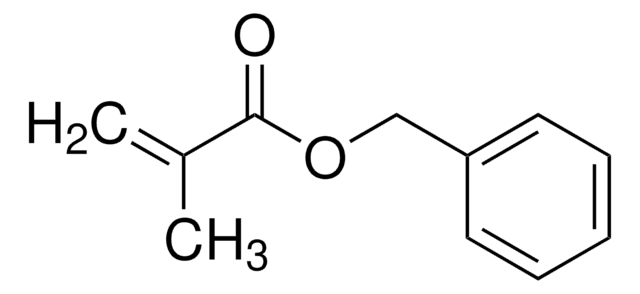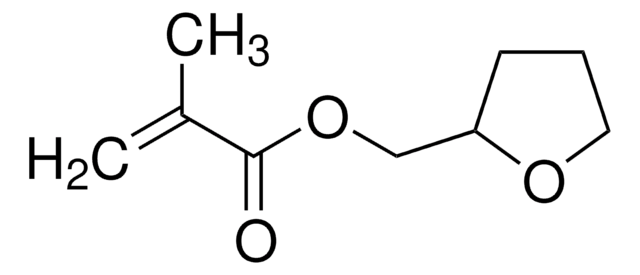290807
2-Ethylhexyl methacrylate
98%, contains ~50 ppm monomethyl ether hydroquinone as stabilizer
Sinonimo/i:
2-EHA, EHMA
About This Item
Prodotti consigliati
Densità del vapore
6.9 (vs air)
Saggio
98%
contiene
~50 ppm monomethyl ether hydroquinone as stabilizer
Indice di rifrazione
n20/D 1.438 (lit.)
P. eboll.
120 °C/18 mmHg (lit.)
Densità
0.885 g/mL at 25 °C (lit.)
Stringa SMILE
CCCCC(CC)COC(=O)C(C)=C
InChI
1S/C12H22O2/c1-5-7-8-11(6-2)9-14-12(13)10(3)4/h11H,3,5-9H2,1-2,4H3
WDQMWEYDKDCEHT-UHFFFAOYSA-N
Cerchi prodotti simili? Visita Guida al confronto tra prodotti
Categorie correlate
Descrizione generale
Applicazioni
- As a monomer to prepare poly(2-phenoxyethyl methacrylate-co-2-phenoxyethyl acrylate-co-2-ethylhexyl methacrylate) (PPPE) intraocular lenses used in cataract treatment. Polymers with 2% 2-ethylhexyl methacrylate are foldable and showed excellent optical and thermomechanical properties.
- To prepare copolymer for the surface modification of dental composite resins to control plaque formation. EHMA imparts water resistance and antifouling properties of dental resins.
- As an internal plasticizer to prepare photo-crosslinked shape memory polymer films used as a photoprintable resins in stereolithography.
- As a precursor to synthesize hydrogels for fabricating contact lenseswith flexibility, permeability, and comfort.
Avvertenze
Warning
Indicazioni di pericolo
Consigli di prudenza
Classi di pericolo
Aquatic Chronic 3 - Eye Irrit. 2 - Skin Irrit. 2 - Skin Sens. 1 - STOT SE 3
Organi bersaglio
Respiratory system
Codice della classe di stoccaggio
10 - Combustible liquids
Classe di pericolosità dell'acqua (WGK)
WGK 1
Punto d’infiammabilità (°F)
197.6 °F - closed cup
Punto d’infiammabilità (°C)
92 °C - closed cup
Dispositivi di protezione individuale
Eyeshields, Gloves, type ABEK (EN14387) respirator filter
Certificati d'analisi (COA)
Cerca il Certificati d'analisi (COA) digitando il numero di lotto/batch corrispondente. I numeri di lotto o di batch sono stampati sull'etichetta dei prodotti dopo la parola ‘Lotto’ o ‘Batch’.
Possiedi già questo prodotto?
I documenti relativi ai prodotti acquistati recentemente sono disponibili nell’Archivio dei documenti.
I clienti hanno visto anche
Il team dei nostri ricercatori vanta grande esperienza in tutte le aree della ricerca quali Life Science, scienza dei materiali, sintesi chimica, cromatografia, discipline analitiche, ecc..
Contatta l'Assistenza Tecnica.














